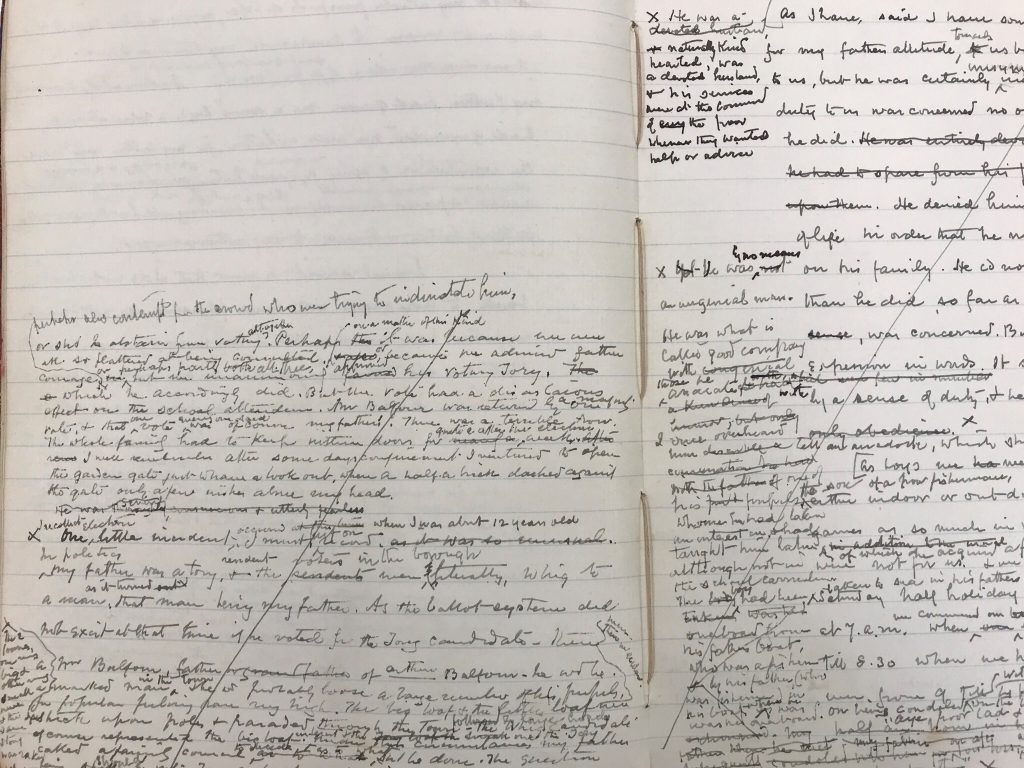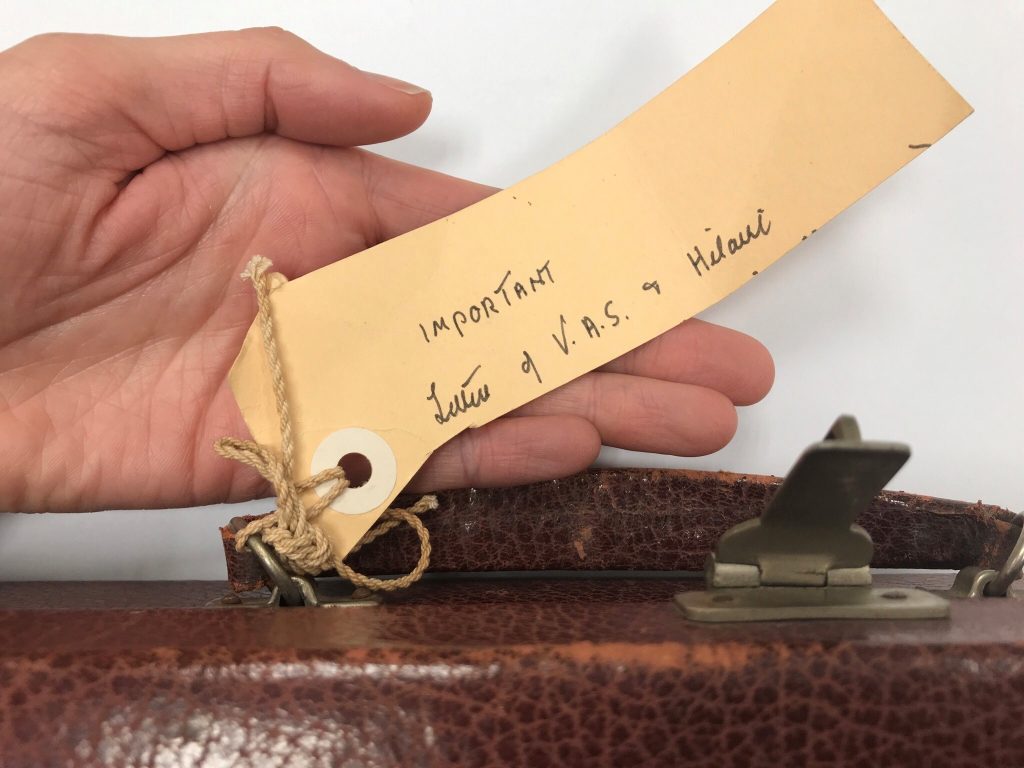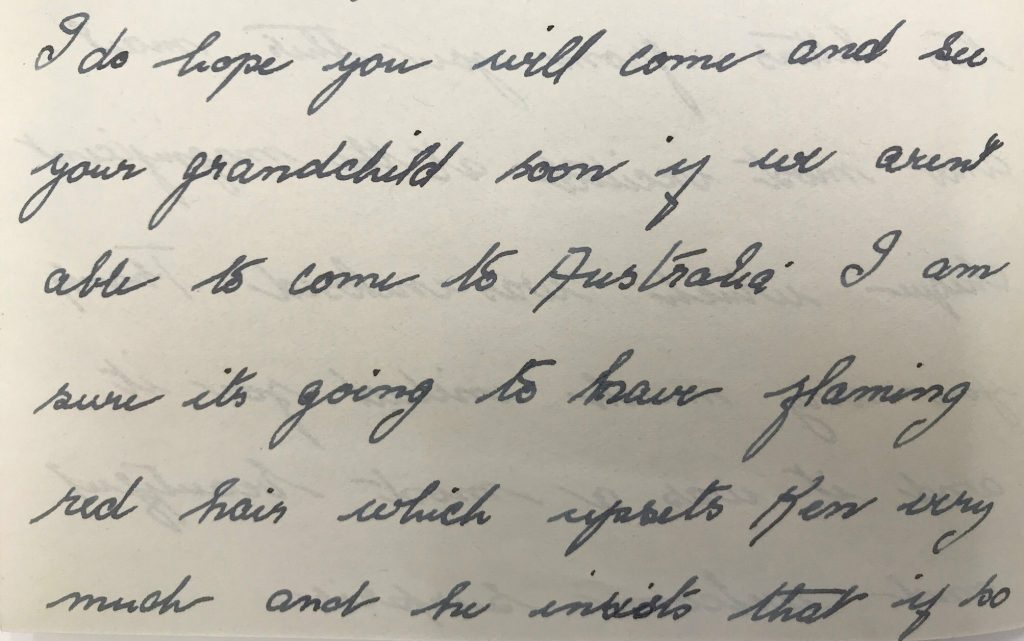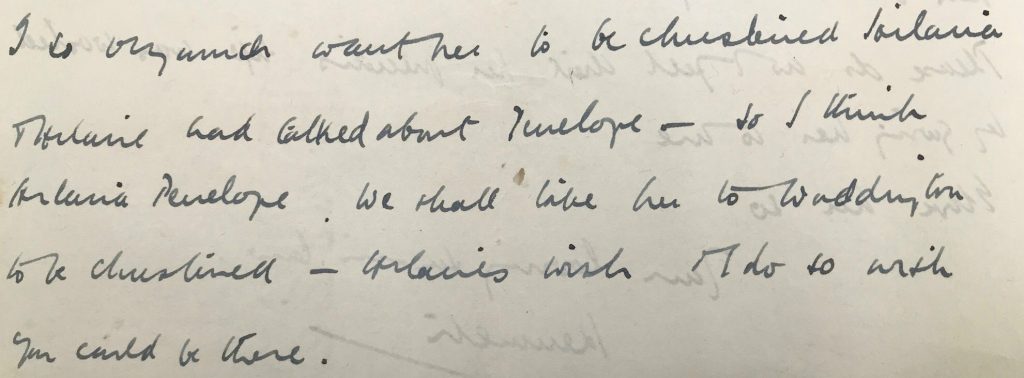A small collection of family papers associated with newspaper proprietor David Syme (1827-1908), publisher and editor-in-chief of The Age from 1859-1908, has recently been re-housed by the Preservation team. The collection includes correspondence, newspaper clippings, documents, diaries and notebooks, and largely relates to David Syme and his son Geoffrey Syme, who was successor to his father at The Age. Several notebooks feature autobiographical writings, by both David and his son reflecting on their professional lives as editorial managers of the The Age.

While re-housing a series of letters found carefully stored within a small writing box, a touching exchange was encountered between Geoffrey’s wife Violet and one of her daughters. Violet Newstead Syme was the second daughter of Geoffrey and Violet, and was called by her nickname Hilaire. Many of the letters were written while Hilaire was living in England, where she had relocated upon meeting her future husband during her first voyage to the continent after she left school. She had been married in England, and was expecting her first child. The letters provide updates on family news and day-to-day life. Violet was always keen to hear of Hilaire’s social engagements and activities in England, at times lamenting that her daughter does not write her often enough.



The last of Hilaire’s letters are dated only weeks before she died soon after giving birth in 1926, at age 21. A detailed letter from Hilaire’s husband, Kenneth Peacock, to Violet Syme, recounts the period after Hilaire gave birth and how her condition deteriorated over several days. His sense of devastation and loss is deeply felt as he tries to make sense of what happened. He notes in his letter that Hilaire seemed tired but well after the birth; yet in the days that followed she became distressed and feverish and in her final hours no longer recognised him. Kenneth writes, ‘They told me it was puerperal mania which sometimes occurs after childbirth but that it was only a temporary condition and she would be all right again’.
In the second half of the 19th century it was thought that childbirth could induce a form of mental collapse in women that was often manic and occasionally fatal; a belief that gained momentum in the Victorian medical profession, both in obstetrics and the newly growing field of psychiatry (Louden 1988, p. 76, Marland 2004, p. 20-21). The terms ‘puerperal insanity’, ‘puerperal mania’ and ‘puerperal melancholia’ were variously employed to describe the condition (Louden 1988, p. 76), and reflect the way in which medical practitioners understood and diagnosed the complications of childbirth at the time, as well as the associated view of women as fragile and unstable, subject to the unpredictability of their bodies and the reproductive process (Marland 2004, p. 20).
The letters Hilaire wrote to her mother and also her father and her siblings become more poignant upon learning of her premature death, and convey the thoughts of a young woman who was looking forward to returning to recreational activities and social commitments after the birth of her first child. In a letter to her father she teasingly writes of her baby: ‘I am sure it’s going to have flaming red hair which upsets Ken very much and he insists that if so he won’t be the father’. The correspondence gives a small personal insight into Geoffrey Syme’s life, outside of his better known professional career as managing editor at The Age, and the perhaps less visible experiences of women at this period of time.



Written by Jessye Wdowin-McGregor, Preservation Technician
References:
Louden, I 1988, Puerperal insanity in the 19th century, Journal of the Royal Society of Medicine, Volume 81, February 1988, p. 76
Marland, H 2004, Dangerous Motherhood: Insanity and Childbirth in Victorian Britain, Palgrave MacMillan, 2004, p. 20-21


Such a poignant story. Is there any information about the baby? A girl, yes, to be called Hilaria Penelope, but red hair??
My heart breaks for Violet, to receive such news. I wonder what became of Ken, and Hilaria.
Thank you for sharing this story, but now to look further.
Thank you for reading the blog article and for your question; it is indeed a heartbreaking story. In this particular collection, there is unfortunately no further information about Hilaria Penelope or Kenneth Peacock – the correspondence largely features the time leading up to and just after Hilaire Syme’s death, but nothing further. There are however a few items in the library catalogue that may offer up some additional information, including an unpublished manuscript by Veronica Condon (nee Syme, sister to Hilaire Syme) on her father Geoffrey Syme, and a family tree, also prepared by Veronica Condon, featuring her family history from 1662-1992. Both can be found via the catalogue here. There is also a series of related material held at the National Library of Australia: Papers of Veronica Condon 1945-2009 (MS 9726) (https://catalogue.nla.gov.au/Record/1102060).
Jessye
The photo of a young Hilaire is as haunting as it is beautiful….a stunning memory of a short-lived life.
I have just come across David Syme as part of my Dip. of Family Studies research. My Great great grandfather – James William Keatch – was contracted to work for Mr. Syme here in Australia for a period of four years. James was an Engineer but was contracted as a printer (machinist) as written on the manifest when he migrates to Australia from England. He brought out his wife and 6 children – 2 of which were infants at the time in 1866. Things don’t turn out well for him as grievances between himself and Mr. Syme ensue based on work practices in 1867. There are published court proceedings: Keatch V. Syme in The Age. As a consequence Keatch loses his case and basically becomes a broken man. I am fascinated to learn more about this. Do you have any more information about Keatch being in his employ?
Hello Jodie, thank you for your query. I have lodged it through our online Ask a Librarian service, and one of our librarians will get in touch. With kind regards,
Kylie
Hi
I have also been studying the Syme family and would like to compare notes. I am currently completing reading the 3rd Syme biography.
Please contact me mikhaeleast@yahoo.com
I have accessed the special collections referenced here and they are indeed fascinating. Veronica Condon’s work needs to be published I think.
I am trying to find more information – specifically the original drawings of the tomb in which David Syme was laid to rest. The tomb predates blueprints, and I have also accessed the collection of Walter Butler (architect) at the library.